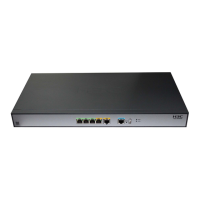1035
display client-verify protected ipv6
Use display client-verify protected ipv6 to display protected IPv6 addresses for client verification.
Syntax
Centralized devices in standalone mode:
display client-verify { dns | http | tcp } protected ipv6 [ ipv6-address [ vpn vpn-instance-name ] ]
[ port port-number ] [ count ]
Distributed devices in standalone mode/centralized devices in IRF mode:
display client-verify { dns | http | tcp } protected ipv6 [ ipv6-address [ vpn vpn-instance-name ] ]
[ port port-number ] [ slot slot-number ] [ count ]
Distributed devices in IRF mode:
display client-verify { dns | http | tcp } protected ipv6 [ ipv6-address [ vpn vpn-instance-name ] ]
[ port port-number ] [ chassis chassis-number slot slot-number ] [ count ]
Views
Any view
Predefined user roles
network-admin
network-operator
Parameters
dns: Specifies the DNS client verification feature.
http: Specifies the HTTP client verification feature.
tcp: Specifies the TCP client verification feature.
ipv6-address: Specifies a protected IPv6 address. If you do not specify an IPv6 address, this
command displays all protected IPv6 addresses.
vpn-instance vpn-instance-name: Specifies the MPLS L3VPN instance to which the protected IPv6
address belongs. The vpn-instance-name argument is a case-sensitive string of 1 to 31 characters.
Do not specify this option if the protected IPv6 address is on the public network.
port port-number: Specifies a protected port in the range of 1 to 65535. If you do not specify a port,
this command displays protected IPv6 addresses with default ports. The default port for DNS client
verification is port 53, the default port for HTTP client verification is port 80, and the default port for
TCP client verification is all ports.
slot slot-number: Specifies a card by its slot number. If you do not specify a card, this command
displays protected IPv6 addresses for all cards. (Distributed devices in standalone mode.)
slot slot-number: Specifies an IRF member device by its member ID. If you do not specify a member
device, this command displays protected IPv6 addresses for all member devices. (Centralized
devices in IRF mode.)
chassis chassis-number slot slot-number: Specifies a card on an IRF member device. The
chassis-number argument represents the member ID of the IRF member device. The slot-number
argument represents the slot number of the card. If you do not specify a card, this command displays
protected IPv6 addresses for all cards. (Distributed devices in IRF mode.)
count: Displays the number of matching protected IPv6 addresses.
Examples
# (Centralized devices in standalone mode.) Display the protected IPv6 addresses for TCP client
verification.
<Sysname> display client-verify tcp protected ipv6

